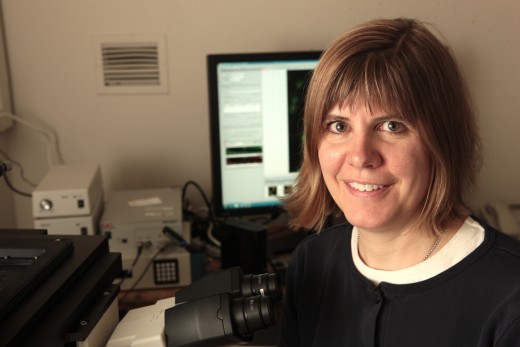Melissa Gardner is using her background in engineering to sort out the interplay between proteins that causes movement, division within cells.

The newest addition to the faculty of the Department of Genetics, Cell Biology and Development didn’t start out as a biologist. She studied chemical engineering as an undergraduate, got her Ph.D. in biomedical engineering and spent years developing and designing medical devices before turning to the biological sciences. But Melissa Gardner’s unconventional background is anything but a liability.
While working on a device used to open clogged arteries, Gardner became intrigued by the fact that the artery seemed to close even faster, accelerating the division process, or mitosis, in response to the intervention. Why would a device designed to open arteries cause such a response? “No one in industry thinks much about the biology side of things,” she says. “I began to wonder if we could make more progress if we understood that better.”
That combination of curiosity about how things work at the cellular level and a real-world problem led Gardner back to the biological sciences – and she’s brought the tools of the engineering trade with her. She uses computation and optics to understand relationships within the cell.
“The biology of the 21st century is going to be unlike anything that has come before,” says Michael O’Connor, the head of the department. “It will involve an unprecedented integration of those with quantitative expertise in mathematics, physics, engineering working with geneticists, cell biologists, biochemists and molecular biologists to provide a more holistic or systems view of how biological processes function. Melissa represents this new breed of investigators who use quantitative approaches to study fundamental biological processes.”
“With genetics and sequencing and genomics there’s now a sort of ‘parts list’ of important players in the cell. And imaging is so good that we now understand where things are in relation to one another,” says Gardner. “What computational biology can do is help bring this together by helping us understand how things work together.”
Gardner is able to create computer models based on the vast amount of data now available to test theories and even help researchers predict outcomes. She describes this approach as a “framework to better understand experimental results.”
Scientists have long known that cellular proteins can trigger movement and division within the cell and organize its regulatory roles. Other proteins play the role of regulator.
“To understand how cells move and divide, it will be important to understand how these forces are generated, transmitted and sensed by the cell,” says Gardner. “Biophysicists have made tremendous progress in understanding how motor proteins exert forces, I think the biggest challenge now is to understand how these motors act as a system inside the cell to coordinate processes such as cell division.”
The lessons learned could provide insight into how to improve cancer drugs and develop more effective treatments for other diseases.
– Stephanie Xenos